Origin/History :-
- The temple is believed to have existed before the 7th century, as evidenced by the hymns of Thirugnanasambandar praising Lord Shiva here. The original temple was likely built with bricks and attributed to Ko Chengat Chozha.
- During the reign of Rajaraja Chola, the temple was reconstructed in stone by Sembiyan Mahadevi, marking a significant transition in its architecture and durability. Further extensions and enhancements were made during the Pandya period.
- The temple has seven recorded inscriptions belonging to various rulers, including the Chozhas (Parakesari, Rajakesari) and the Pandyas. No mediaeval period inscriptions have been found at the site.
- Inscriptions document the endowment of perpetual lamps, often accompanied by land grants. Notable donations include 90 sheep/goats by Vetkovan Pukazhan MunnooRRuvan of Thirumeeyachur and the conversion of uncultivated land into cultivable land gifted by Yaazhakan.
- A 15th to 16th-century inscription documents various endowments for perpetual lamps, a Pooja mandapam, a Mathilsala Samudram tank, and a farm with fruit trees. Another inscription from Parakesarivarman Prantaka Chozha I’s 15th reign year mentions the endowment of musical instruments.
- A fragmentary inscription from the 10th to 11th century records donations from various women for the burning of Sandhi lamps.
- The temple was referred to as Mihiraruneswarar Temple at Thirumeeyachur according to Nannilam Vattak Kalvettukal and SII inscription Volume 8, though it is unclear if this name referred to Lord Shiva or another temple.
- Inscriptions from the Pandya dynasty detail taxes levied for temple upkeep and offerings, using currency referred to as Bhuvanesuveeran kasu.
- The temple underwent significant renovations, leading to Maha Kumbhabhishekam ceremonies conducted on November 3, 2000, and February 8, 2015.
- The Lalithambigai Temple is currently under the administrative control of the Thirupugalur Velakurichi Adheenam.
Puranic Significance :-
- Sthalapuranam 1 :
The dreaded demon Pandasura was tormenting sages and Devas, causing great distress. In their desperation, they surrendered to Mother Parasakthi, seeking her protection. Responding to their pleas, Devi emerged from a Yaga Gunda, mounted on the Sri Chakra Rath, taking on the name Lalithambika. She engaged in a fierce battle with the demon and ultimately vanquished him.
However, in her fury, Lord Shiva advised Mother to descend to Earth, assume the name Manonmani, and perform penance to temper her anger. Following this guidance, Mother came to this sacred place, where she transformed into a figure of compassion and mercy.
In her benevolence, she created the Vak Devathas, deities who govern words, and instructed them to sing her praises using a thousand names. This divine hymn became known as the Lalitha Sahasranama, beginning with the invocation "Sri Mathre," meaning "Mother of Prosperity."
- Sthalapuranam 2 :
Sage Kashyapa had two wives, Vinatha and Karthru, who fervently prayed to Lord Shiva for the boon of children. In response to their prayers, the Lord gifted each of them an egg, instructing them to keep it safe for a year. From the egg of Vinatha, Garuda was born, who later became the divine vehicle (Vahan) of Lord Vishnu.
However, Karthru grew anxious as nothing emerged from her egg. In her haste, she broke it open, only to find a disfigured child. Realising her mistake, she sought Lord Shiva's pardon for her impulsive action. The Lord not only forgave her but also blessed the child, naming him Aruna. He became the charioteer of the Sun, and the dawn was referred to as Arunodhaya.
Aruna, devoted to Lord Shiva, performed severe penance to attain his darshan. The Sun, mocking Aruna's physical defects, suggested that he could never reach Kailash for a divine vision. Undeterred by the Sun's taunts, Aruna persisted in his efforts and ultimately succeeded in gaining Lord Shiva's darshan.
In response to Aruna’s determination, Lord Shiva also cursed the Sun to lose his shining brilliance. Shocked by this consequence, the Sun humbly placed Lord Parameswara and Mother Parvati on an elephant, worshipped them, and was restored to his former glory.
This sacred narrative culminates in the temple of Meeyachur, where Lord Shiva is worshipped as Lord Meganatha. He resides under the Gajabrushta Vimana, designed to resemble the back of an elephant, adorned with three Kalasas. The presiding deity, Meganatha Swami, faces east, while Mother Lalithambika, also known as Soundarya Nayaki, majestically sits on the Sri Chakra throne, embodying the grace of an empress.
